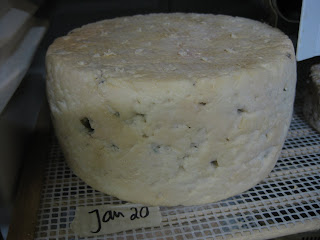
The other day I watched a documentary called "The Cheese Nun" about Sister Noella Marcellino. Sister Noella Marcellino is a Benedictine nun at the Abbey of Regina Laudis in Bethlehem, Connecticut. She began making the Abbey’s cheese in 1977 using an ancient technique taught to her by a French woman. Pursuing a doctorate in Microbiology in the Department of Molecular and Cell Biology at UConn in 2003, she traveled extensively through cheese-making regions in France collecting native strains of cheese-ripening fungi to access their biochemical and genetic diversity. She isolated hundreds of species of the fungi Geotrichum candidum, one of the keys to the uniqueness of every cheese. She collected samples of the microflora from the milk, cheeses and caves. Back in the lab she studied the samples and discovered that each cave has its distinct microflora. Even caves a few miles apart might be inhabited by different strains of the fungi. This is one reason why cheeses are so distinct to their locality.
After watching the documentary, I went to look for some of the sister's publications. I found two and have read one so far. Published in the November 1992 issue of Applied and Environmental Microbiology I found "Scanning Electron and Light Microscopic Study of Microbial Succession on Bethlehem St. Nectaire Cheese". A very interesting article about the developmental stages of the microorganisms on this particular cheese. She describes the biochemical activity of the texture and flavor developing microbial populations on this mold ripened cheese.
As said, all caves have a distinct microflora living in them which are influential to the development of the cheese. After reading this paper I tried to do a little research on the microbial population in my cave by studying the rind of the St. Nectaire I made a while ago. Of course I don't have a microscope, nor can I determine which fungus or mold is what. But after a close look at the rind, I can conclude that my cave does not have a very diverse population. I think I can recognize a strain of G. candidum (the white mold in the pictures) and a strain of Mucor (the grey mold in the pictures). This is nothing like the ten to twelve microorganisms mentioned in the scientific paper by Sister Noelle. As I had always suspected, this cave is rather sterile. It is a poured concrete structure under the Brooklyn sidewalk. It does not compare to the cave upstate, which I use in the summer when it gets to hot in the city. The pictures of the rind of those cheeses will attest to that. The rinds are colorful, evidence of a very diverse and abundantly present population of microorganisms.
After watching the documentary, I went to look for some of the sister's publications. I found two and have read one so far. Published in the November 1992 issue of Applied and Environmental Microbiology I found "Scanning Electron and Light Microscopic Study of Microbial Succession on Bethlehem St. Nectaire Cheese". A very interesting article about the developmental stages of the microorganisms on this particular cheese. She describes the biochemical activity of the texture and flavor developing microbial populations on this mold ripened cheese.
As said, all caves have a distinct microflora living in them which are influential to the development of the cheese. After reading this paper I tried to do a little research on the microbial population in my cave by studying the rind of the St. Nectaire I made a while ago. Of course I don't have a microscope, nor can I determine which fungus or mold is what. But after a close look at the rind, I can conclude that my cave does not have a very diverse population. I think I can recognize a strain of G. candidum (the white mold in the pictures) and a strain of Mucor (the grey mold in the pictures). This is nothing like the ten to twelve microorganisms mentioned in the scientific paper by Sister Noelle. As I had always suspected, this cave is rather sterile. It is a poured concrete structure under the Brooklyn sidewalk. It does not compare to the cave upstate, which I use in the summer when it gets to hot in the city. The pictures of the rind of those cheeses will attest to that. The rinds are colorful, evidence of a very diverse and abundantly present population of microorganisms.
































